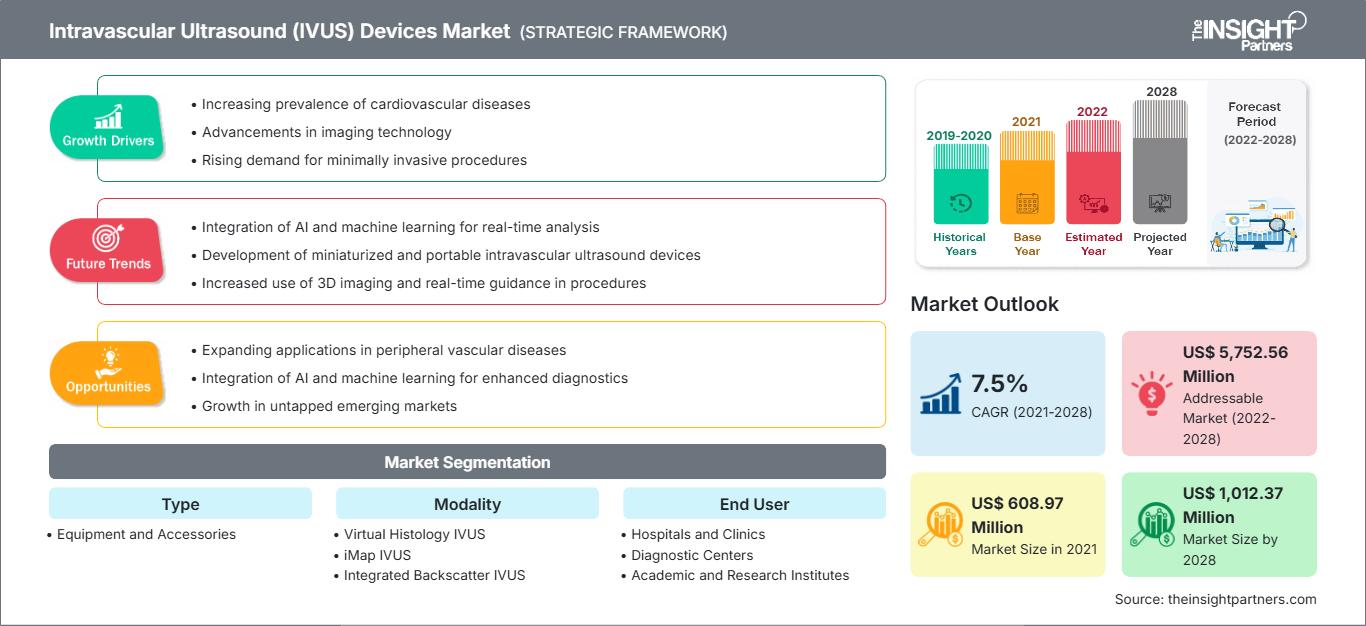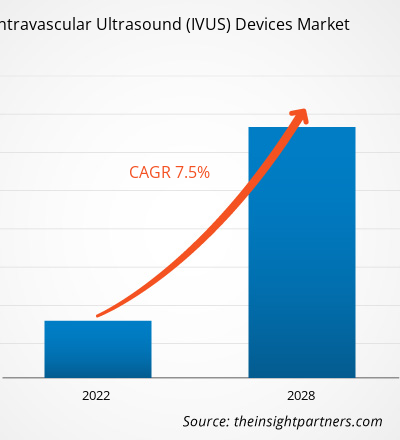[Rapporto di ricerca]Si prevede che il mercato dei dispositivi per ecografia intravascolare (IVUS) crescerà da 608,97 milioni di dollari nel 2021 a 1.012,37 milioni di dollari entro il 2028; si stima una crescita a un CAGR del 7,5% dal 2021 al 2028.
Il rapporto offre approfondimenti e analisi approfondite del mercato dei dispositivi per ecografia intravascolare (IVUS) in relazione a vari parametri, quali tendenze e opportunità di mercato, dinamiche di mercato e analisi del panorama competitivo dei principali attori del mercato in Nord America, Europa, Asia-Pacifico, Sud e Centro America e Medio Oriente e Africa. Include anche l'analisi dell'impatto della pandemia di COVID-19 nelle diverse regioni.
Personalizza questo rapporto in base alle tue esigenze
Potrai personalizzare gratuitamente qualsiasi rapporto, comprese parti di questo rapporto, o analisi a livello di paese, pacchetto dati Excel, oltre a usufruire di grandi offerte e sconti per start-up e università
Mercato dei dispositivi per ultrasuoni intravascolari (IVUS): Approfondimenti strategici

- Ottieni le principali tendenze chiave del mercato di questo rapporto.Questo campione GRATUITO includerà l'analisi dei dati, che vanno dalle tendenze di mercato alle stime e alle previsioni.
Potrai personalizzare gratuitamente qualsiasi rapporto, comprese parti di questo rapporto, o analisi a livello di paese, pacchetto dati Excel, oltre a usufruire di grandi offerte e sconti per start-up e università
Mercato dei dispositivi per ultrasuoni intravascolari (IVUS): Approfondimenti strategici

- Ottieni le principali tendenze chiave del mercato di questo rapporto.Questo campione GRATUITO includerà l'analisi dei dati, che vanno dalle tendenze di mercato alle stime e alle previsioni.
Approfondimenti di mercato
Aumento dei disturbi cardiovascolari
Le malattie cardiovascolari continuano a essere la causa principale di morbilità e mortalità a livello mondiale. Una dieta non sana è il fattore di stile di vita più importante che porta alle malattie cardiovascolari. Secondo l'OMS, le malattie cardiovascolari sono una delle cause di morte, con quasi 17,9 milioni di decessi in tutto il mondo nel 2019.
Alcuni dei principali fattori di rischio delle malattie cardiovascolari includono la familiarità, l'etnia, l'età e altri fattori di rischio: consumo di tabacco, ipertensione, obesità, colesterolo alto, inattività fisica, diabete, diete non sane e consumo di alcol. La maggior parte delle malattie cardiovascolari può essere prevenuta attraverso il pre-monitoraggio e la pre-diagnosi utilizzando dispositivi ecografici intravascolari. Pertanto, il crescente numero di malattie cardiovascolari sta incrementando la domanda di dispositivi ecografici intravascolari.
A causa della pandemia di COVID-19, la domanda di dispositivi ecografici intravascolari (IVUS) è aumentata. È probabile che il mercato dei dispositivi ecografici intravascolari (IVUS) nella regione Asia-Pacifico si espanda rapidamente nel prossimo futuro. Questa espansione può essere attribuita principalmente alla disponibilità di tecnici qualificati e formati e all'aumento dell'adozione di apparecchiature diagnostiche tecnologicamente avanzate.
Approfondimenti basati sulla modalità
In base alla modalità, il mercato dei dispositivi ecografici intravascolari (IVUS) è segmentato in IVUS per istologia virtuale, IVUS iMap e IVUS con backscatter integrato. Nel 2021, il segmento IVUS per istologia virtuale deteneva una quota di mercato maggiore. Tuttavia, si stima che il segmento IVUS iMap registrerà un CAGR più elevato, pari all'8,0%, durante il periodo di previsione.
Mercato dei dispositivi ecografici intravascolariMercato dei dispositivi per ultrasuoni intravascolari (IVUS)
Mercato dei dispositivi per ultrasuoni intravascolari (IVUS)
Le tendenze regionali e i fattori che influenzano il mercato dei dispositivi per ecografia intravascolare (IVUS) durante il periodo di previsione sono stati ampiamente spiegati dagli analisti di The Insight Partners. Questa sezione illustra anche i segmenti di mercato e la distribuzione geografica dei dispositivi per ecografia intravascolare (IVUS) in Nord America, Europa, Asia-Pacifico, Medio Oriente e Africa, America meridionale e centrale.
Ambito del rapporto di mercato sui dispositivi a ultrasuoni intravascolari (IVUS)
| Attributo del rapporto | Dettagli |
|---|---|
| Dimensioni del mercato in 2021 | US$ 608.97 Million |
| Dimensioni del mercato per 2028 | US$ 1,012.37 Million |
| CAGR globale (2021 - 2028) | 7.5% |
| Dati storici | 2019-2020 |
| Periodo di previsione | 2022-2028 |
| Segmenti coperti |
By Tipo
|
| Regioni e paesi coperti | Nord America
|
| Leader di mercato e profili aziendali chiave |
|
Densità degli operatori del mercato dei dispositivi per ultrasuoni intravascolari (IVUS): comprendere il suo impatto sulle dinamiche aziendali
Il mercato dei dispositivi per ecografia intravascolare (IVUS) è in rapida crescita, trainato dalla crescente domanda degli utenti finali, dovuta a fattori quali l'evoluzione delle preferenze dei consumatori, i progressi tecnologici e una maggiore consapevolezza dei benefici del prodotto. Con l'aumento della domanda, le aziende stanno ampliando la propria offerta, innovando per soddisfare le esigenze dei consumatori e sfruttando le tendenze emergenti, alimentando ulteriormente la crescita del mercato.

- Ottieni il Mercato dei dispositivi per ultrasuoni intravascolari (IVUS) Panoramica dei principali attori chiave
Approfondimenti basati sulla tipologia
In base alla tipologia, il mercato dei dispositivi per ecografia intravascolare (IVUS) è segmentato in apparecchiature e accessori. Nel 2021, il segmento degli accessori ha detenuto una quota di mercato maggiore e si stima che lo stesso segmento registrerà un CAGR più elevato del 7,7% nel mercato durante il periodo di previsione.
Approfondimenti basati sull'utente finale
In base all'utente finale, il mercato dei dispositivi per ecografia intravascolare (IVUS) è segmentato in ospedali e cliniche, centri diagnostici e istituti accademici e di ricerca. Nel 2021, il segmento ospedali e cliniche ha detenuto una quota di mercato maggiore. Tuttavia, si stima che il segmento dei centri diagnostici registrerà un CAGR più elevato, pari al 7,9%, durante il periodo di previsione.
Le aziende adottano comunemente strategie inorganiche, come fusioni e acquisizioni, per soddisfare le mutevoli esigenze dei clienti e mantenere i propri marchi in tutto il mondo. Gli operatori che operano nel mercato dei dispositivi per ultrasuoni intravascolari (IVUS) adottano anche strategie organiche, come il lancio e l'espansione dei prodotti, per ampliare la propria presenza e il portafoglio prodotti in tutto il mondo e soddisfare la crescente domanda.
Per tipo
- Attrezzatura
- Cateteri
- Guide
- Altro
- Accessori
Per modalità
- IVUS per istologia virtuale
- IVUS iMap
- IVUS con retrodiffusione integrata
Per utente finale
- Ospedali e cliniche
- Istituti accademici e di ricerca
- Centri diagnostici
Per area geografica
- Nord America
- Stati Uniti
- Canada
- Messico
- Europa
- Regno Unito
- Germania
- Francia
- Italia
- Spagna
- Resto d'Europa
- Asia Pacifico
- Cina
- Giappone
- India
- Australia
- Corea del Sud
- Resto dell'Asia Pacifico
- Medio Oriente e Africa
- Emirati Arabi Uniti
- Arabia Saudita
- Africa
- Resto del Medio Oriente e Africa
- America del Sud e Centro
- Brasile
- Argentina
- Resto dell'America del Sud e Centro
Profili aziendali
- Koninklijke Philips NV
- GE Healthcare
- Siemens AG
- Boston Scientific Corporation
- Infraredx, Inc.
- Terumo Corporation
- Axle International
- Conavi Medical Inc.
- Canon Medical Systems
- Abbott
- ACIST Medical System
- Analisi storica (2 anni), anno base, previsione (7 anni) con CAGR
- Analisi PEST e SWOT
- Valore/volume delle dimensioni del mercato - Globale, Regionale, Nazionale
- Industria e panorama competitivo
- Set di dati Excel
Report recenti
Testimonianze
Motivo dell'acquisto
- Processo decisionale informato
- Comprensione delle dinamiche di mercato
- Analisi competitiva
- Analisi dei clienti
- Previsioni di mercato
- Mitigazione del rischio
- Pianificazione strategica
- Giustificazione degli investimenti
- Identificazione dei mercati emergenti
- Miglioramento delle strategie di marketing
- Aumento dell'efficienza operativa
- Allineamento alle tendenze normative




















 Ottieni un campione gratuito per - Mercato dei dispositivi per ultrasuoni intravascolari (IVUS)
Ottieni un campione gratuito per - Mercato dei dispositivi per ultrasuoni intravascolari (IVUS)